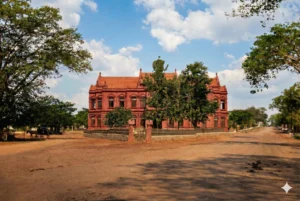
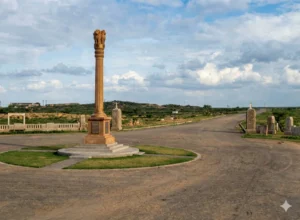
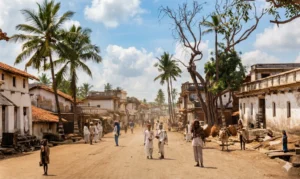

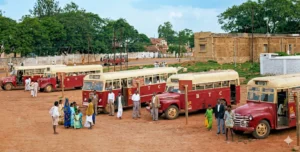

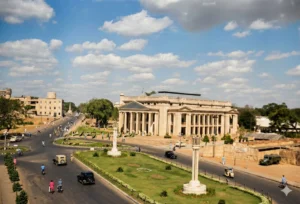
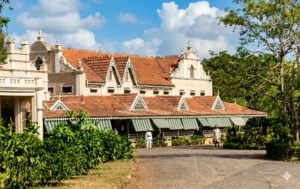

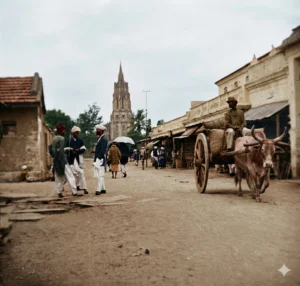
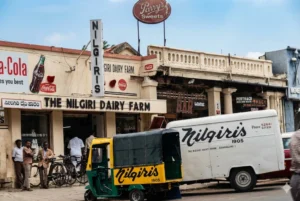

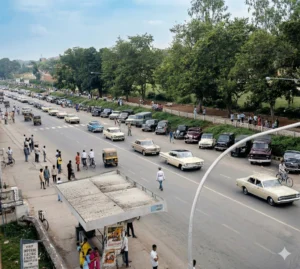
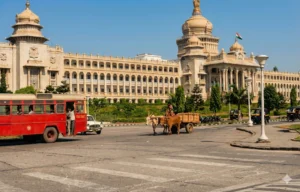
Mayo Hall: The Brick Red Sentinel in 1890s
The building was deliberately constructed on an elevated area, to provide commanding views of the surroundings, which included the military parade grounds and Ulsoor Lake in the distance. This is an AI restored photo from an 1890 photograph. The M.G. Road of today was then called South Parade Road.
Ashoka Pillar: The Last Outpost in 1948
Hard to believe, but this pillar once marked the literal southern end of the Bengaluru city. The Ashoka pillar was built in 1948 at a cost of Rs 3000 to mark the birth of Jayanagar extension in Bangalore. Jayanagar was named after the last ruler of the kingdom of Mysore – Jayachamrajendra Wodeyar.
Before the endless sprawl of Jayanagar and JP Nagar, there was just this solitary column standing guard over a quiet, dusty intersection. The Ashoka Pillar photograph restored using AI is from 1948!
Avenue Road: The Artery That Never Sleeps
Some things never change. Even in 1890s, Bangalore’s Avenue Road was the bustling commercial heart of the Pettah. Notice the distinct lack of plastic signage. Wish one could time travel back to those days and stay in that old Namma Bengaluru.
Brigade Road: Before the Neon
Step back into the 80s. It seems almost impossible today, but there was a time when a cyclist could casually ride down the center of Brigade Road without a care in the world! The restoration brings the era to life in vivid color—from the Fiat Padminis and Ambassadors ruling the tarmac to the pedestrians in their casual slacks strolling down the pavement. There’s a distinct lack of urgency here. No honking, no rush—just the ‘Garden City’ moving at its own gentle pace past the iconic stone buildings that still stand today
Shivajinagar Bus Stand : The BTC Era of 1950s
It is jarring to see Shivajinagar like this in 1950 —not a concrete jungle, but a vast expanse of Bangalore’s signature red earth (Kemmannu). No platforms, no shelters, just a simple open ground where passengers in dhotis and sarees waited patiently under the open sky. It’s a scene of rural tranquility in the heart of the city.
Zoom in on the side of the buses. Before it became the BTS or the BMTC, it was the ‘Bangalore Transport Company’ (BTC). This 1950s snapshot captures the fleet of bonnet-nosed Bedfords (likely Bedford or Chevrolet models common in the 50s).
A time when catching a bus was a slow, deliberate affair. The photo captures a lazy afternoon rhythm—conductors leaning against the rails, passengers chatting in groups. It’s Shivajinagar, but it feels like a village square.
Vrishabhavati River: The Clear Water in 1960s
This is perhaps the most heartbreaking and beautiful restoration of the lot. Before it became a sewage channel referred to as Kengeri Mori – its unpopular name, which is what we have made it into today – the Vrishabhavati was a sparkling, holy river. A stunning, painful reminder of what we lost.
Town Hall: The Stone Stage in 1940s
The steps of Town Hall have seen a thousand protests and a million plays. This shot freezes a moment when the stairs were pristine and the road in front was shockingly empty!
West End Hotel: The Colonial Retreat
While the rest of the city hustled, the West End was an island of luxury. The photo enhancement from 1917 brings out the texture of the tiled roofs and the sprawling, manicured lawns where time seemed to stand still. High tea, anyone?
Halasuru (Ulsoor) Someshwara Temple: The Ancient Guardian
Older than the city itself. The restoration of this Chola-era masterpiece as seen in 1868 highlights the intricate carvings on the Gopuram that are usually lost in grainy photos. You can see the devotion in the architecture, standing serene near the banks of the lake.
St. Mary’s Basilica: Touching the Sky in 1900s
Before the skyscrapers, the spire of St. Mary’s was the highest point your eye could find in Shivajinagar. And yes, that is Commercial Street of Namma Bengaluru in 1900s :)
Nilgiris: The Dairy Farm Days in 1939
Before it was the supermarket giant we knew, it was the quaint ‘Nilgiri Dairy Farm.’ The AI colorization makes the old signage pop, and you can almost smell the fresh butter and bread through the screen. A nostalgic look at the shop in 1939 that introduced Bangalore to the joy of cake.
Kempegowda Theatre: The Golden Run
For the modern generation, a ‘hit’ movie lasts two weeks. In 1974, Dr. Rajkumar’s masterpiece Bangarada Manushya ran for over two years! Those were the days when a movie ticket cost around 70 paisa (Yes, less than a rupee) !!.
You can clearly read the massive Kannada banner, see the traditional banana stems tied to the pillars for good luck, and feel the festive energy. This wasn’t just a movie; it was a movement that inspired educated youth to return to farming.
M.G. Road in 1972 – The Boulevard We Lost
To the right of the frame lies the most painful loss for old-time Bangaloreans: the M.G. Road Boulevard. Before the Metro pillars took over, this was a lush, green promenade where people gathered to watch the world go by. The restoration from 1972 brings out the vibrant green of the canopy and the relaxed crowd lining the railing. It’s a Sunday morning scene that feels remarkably European, yet distinctly Bangalore.
Look at the gleaming chrome on that cream-colored American sedan (likely a Chevrolet or Plymouth) cruising down the center lane, flanked by the humble Ambassadors and Fiats. The movie poster near the bus stand is of the 1972 Kannada movie Nanda Gokula.
Power and the Plough: The Ultimate Contrast
Completed in the 1950s, this is the ‘youngest’ icon on our list. Only in India, and specifically in 1980s Bangalore, could you see this scene. On one side, the Vidhana Soudha—the imposing seat of legislative power built from granite. On the other, a humble bullock cart making its way down the main road, unfazed by the red BTS bus passing by.
A Note on Image Sources & Credits
The vintage photographs used as the foundation for these AI restorations were carefully curated from various historical archives, public forums, and open-source collections across the web. We deeply respect the history captured in these frames. While the restoration, upscaling, and colorization work was performed by us using modern AI tools, the artistic merit belongs entirely to the original photographers who captured these moments in time.
Due to the age and archival nature of these images, tracing specific original attribution is often difficult. If you are the original photographer or the copyright holder of the source material for any of these images, please reach out to us. We would be honored to update the post with proper credit and provide a direct link to your website or portfolio.
Special thanks to Google’s Nano Banana for the amazing image enhancement. It was the magic wand that turned the grainy archival shots into the high-definition masterpieces you see above.


